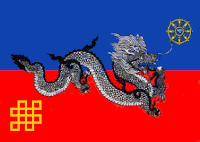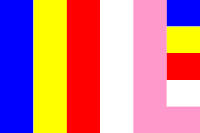
The flag later came to symbolize the unity of all Buddhists. Thereafter, it has been used worldwide in nearly 60 countries during Buddhist festive events, particularly during Vesak celebrations commemorating the Buddha's birth, enlightenment, and nirvana. Col. Olcott was one of the greatest American Buddhists who dedicated his later life entirely to the people of Asia.
He is known as the father of the Buddhist education movement since he initiated the establishment of close to 400 Buddhist schools and colleges in Sri Lanka.
Col. Olcott designed a flag from the six colors of the Buddha's aura, which is commonly believed to have shone around the head of the Buddha after his great enlightenment (maha bodhi). The vertical stripes of the flag are of five colors with the following symbolism:
- Blue: universal compassion
- Yellow: the Middle Path
- Red: blessings
- White: purity and liberation
- Orange: wisdom
- Combination: truth
The colors represent these bio-luminescent radiances for the following reasons:
- The sentiment of other "Buddhist flags" is less universal. Read more









































































































































































































































No comments:
Post a Comment